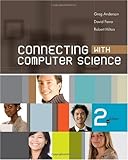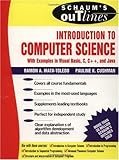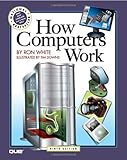|
|
Help |
| Home - Science - Computer Science (Books) | |
e99 Online Shopping Mall
|
|
Help |
| Home - Science - Computer Science (Books) | |
| Back | 21-40 of 100 | Next 20 |
click price to see details click image to enlarge click link to go to the store
| 21. Connecting with Computer Science by Greg Anderson, David Ferro, Robert Hilton | |
 | Paperback: 640
Pages
(2010-01-14)
list price: US$118.95 -- used & new: US$83.24 (price subject to change: see help) Asin: 1439080356 Average Customer Review: Canada | United Kingdom | Germany | France | Japan |
|
Editorial Review Product Description Customer Reviews (4)
| |
| 22. Foundations of Computer Science: C Edition (Principles of Computer Science Series) by Alfred V. Aho, Jeffrey D. Ullman | |
 | Hardcover: 786
Pages
(1994-10-15)
-- used & new: US$150.63 (price subject to change: see help) Asin: 0716782847 Average Customer Review: Canada | United Kingdom | Germany | France | Japan |
|
Editorial Review Product Description Customer Reviews (12)
No, it's not introductory, but if you're having a hard time with Discrete Math and have a solid programming background, are willing to sit down and "Work out" the excercises, then this book is for you.
For those new to computer science, I would not use this as a first book (this is made clear in the introduction, as well). The expectation is that the reader will already understand the basics of programming, so prior experience or an introductory course in computer science would be appropriate. Many of the examples make use of pointers, which can occasionally be confusing to students unfamiliar with programming, so it would definitely be a good idea for the reader to be familiar with a language like C or Pascal before starting this book. Once that foundation is in place, this is an excellent book to learn the basics of the field of computer science. For more experienced readers, this book serves as an amazing review and does a good job of collecting lots of information in one place. Explanations are solid, so the book can serve as a good reference for multiple topics. Note that the level of detail is not appropriate if you are just interested in one thing -- if you are interested only in details of algorithms, a book like the MIT Press Algorithms book would be more appropriate.
| |
| 23. Quantum Computer Science: An Introduction by N. David Mermin | |
 | Hardcover: 236
Pages
(2007-09-17)
list price: US$48.99 -- used & new: US$13.20 (price subject to change: see help) Asin: 0521876583 Average Customer Review: Canada | United Kingdom | Germany | France | Japan |
|
Editorial Review Product Description Customer Reviews (1)
| |
| 24. Formal Concept Analysis: Foundations and Applications (Lecture Notes in Computer Science / Lecture Notes in Artificial Intelligence) | |
 | Paperback: 349
Pages
(2005-08-23)
list price: US$89.95 -- used & new: US$63.03 (price subject to change: see help) Asin: 3540278915 Canada | United Kingdom | Germany | France | Japan |
|
Editorial Review Product Description Formal concept analysis has been developed as a field of applied mathematics based on the mathematization of concept and concept hierarchy. It thereby allows us to mathematically represent, analyze, and construct conceptual structures. The formal concept analysis approach has been proven successful in a wide range of application fields. This book constitutes a comprehensive and systematic presentation of the state of the art of formal concept analysis and its applications. The first part of the book is devoted to foundational and methodological topics. The contributions in the second part demonstrate how formal concept analysis is successfully used outside of mathematics, in linguistics, text retrieval, association rule mining, data analysis, and economics. The third part presents applications in software engineering. | |
| 25. Java: An Introduction to Computer Science and Programming, Third Edition by Walter Savitch | |
 | Paperback: 976
Pages
(2003-04-07)
list price: US$92.00 -- used & new: US$63.95 (price subject to change: see help) Asin: 0131013785 Average Customer Review: Canada | United Kingdom | Germany | France | Japan |
|
Editorial Review Product Description Customer Reviews (47)
| |
| 26. Schaum's Outline of Introduction to Computer Science by Pauline Cushman, Ramon Mata-Toledo | |
 | Paperback: 240
Pages
(1999-09-03)
list price: US$16.95 -- used & new: US$31.61 (price subject to change: see help) Asin: 007134554X Average Customer Review: Canada | United Kingdom | Germany | France | Japan |
|
Editorial Review Product Description Customer Reviews (2)
| |
| 27. Explorations In Computer Science by Mark Meyer | |
 | Paperback: 281
Pages
(2005-12-19)
list price: US$54.95 -- used & new: US$105.90 (price subject to change: see help) Asin: 0763738328 Canada | United Kingdom | Germany | France | Japan |
|
Editorial Review Product Description | |
| 28. Computer Science & Perl Programming: Best of TPJ by Jon Orwant | |
 | Paperback: 744
Pages
(2002-11-15)
list price: US$39.95 -- used & new: US$22.80 (price subject to change: see help) Asin: 0596003102 Average Customer Review: Canada | United Kingdom | Germany | France | Japan |
|
Editorial Review Product Description Customer Reviews (5)
Computer Science and Perl Programming is a collection of 70 articles from The Perl Journal. It is the first volume of a set of three and, in my opinion, the best volume. Jon Orwant, the original editor of The Perl Journal, has done a great job in putting together this volume. This volume is divided into tips for beginners, regular expressions, data structures, networking, databases, software development processes, object-oriented programming, and advanced Perl programming techniques. I particularly enjoyed the regular expressions, and networking sections. The data structures section was also very useful, as data structures in Perl can tend to be a bit odd. This volume has a good bit of programming knowledge crammed into it, and seems to be a bit more serious than the other two volumes. All in all, a great read and a great reference to keep around. I would definitely advise anyone interested in Perl to pick up this set, you won't regret it.
CS & PP is divided into seven sections as follows: Beginner Concepts, Regular Expressions, Computer Science, Programming Techniques, Software Development, Networking and Databases. The articles are straight reprints from TPJ and are written by a number of leading perl people such as Larry Wall, Damian Conway, Mark Jason Dominus, etc. Jon Orwant, the publisher of TPJ is the editor for this book. I haven't finished this book yet but I've greatly enjoyed the articles I've read. A vast array of topics are covered, such as B-Trees, random number generators, benchmarking, makemaker, DBI and even Win32::ODBC and Microsoft Office. There's something for every perl programmer in this book. Highly recommended. ... Read more | |
| 29. Discrete Mathematics in Computer Science by Donald F. Stanat, David F. McAllister | |
| Hardcover: 850
Pages
(1977-03)
list price: US$70.30 -- used & new: US$29.94 (price subject to change: see help) Asin: 0132161508 Average Customer Review: Canada | United Kingdom | Germany | France | Japan | |
Customer Reviews (1)
| |
| 30. Balanced Introduction to Computer Science, A (3rd Edition) by David Reed | |
 | Paperback: 432
Pages
(2010-09-10)
list price: US$109.00 -- used & new: US$67.00 (price subject to change: see help) Asin: 0132166755 Average Customer Review: Canada | United Kingdom | Germany | France | Japan |
|
Editorial Review Product Description A Balanced Introduction to Computer Science, 3/e is ideal for Introduction to Computing and the Web courses in departments of Math and Computer Science. This thoughtfully written text uses the Internet as a central theme, studying its history, technology, and current use. Experimental problems use Web-based tools, enabling students to learn programming fundamentals by developing their own interactive Web pages with HTML and JavaScript. Integrating breadth-based and depth-based chapters, Reed covers a broad range of topics balanced with programming depth in a hands-on, tutorial style. Customer Reviews (4)
| |
| 31. How to Prepare for the AP Computer Science Exam (Barron's How to Prepare for the Ap Computer ScienceAdvanced Placement Examination) by Roselyn Teukolsky | |
 | Paperback: 656
Pages
(2003-08-01)
list price: US$16.95 -- used & new: US$12.00 (price subject to change: see help) Asin: 0764121944 Average Customer Review: Canada | United Kingdom | Germany | France | Japan |
|
Editorial Review Product Description Customer Reviews (6)
| |
| 32. How Computers Work (9th Edition) by Ron White, Timothy Edward Downs | |
 | Paperback: 464
Pages
(2007-11-24)
list price: US$34.99 -- used & new: US$19.98 (price subject to change: see help) Asin: 0789736136 Average Customer Review: Canada | United Kingdom | Germany | France | Japan |
|
Editorial Review Product Description Having sold more than 2 million copies over its lifetime, How Computers Work is the definitive illustrated guide to the world of PCs and technology. In this new edition, you’ll find detailed information not just about every last component of hardware found inside your PC, but also in-depth explanations about home networking, the Internet, PC security, and even how cell phone networks operate. Whether you’re interested in how the latest graphics cards power today’s most demanding games or how a digital camera turns light into data, you’ll find your answers right here. Ron White is a former executive editor and columnist for PC Computing, where he developed the visual concept behind How Computers Work. Founder of one of the earliest PC user groups, he has been writing about computers for 25 years and is known for building wildly extreme computers. Timothy Edward Downs is an award-winning magazine designer, illustrator, and photographer. He has directed and designed several national consumer, business, technology, and lifestyle magazines, always infusing a sense of “how it works” into every project. A full-color, illustrated adventure into the wonders of TECHNOLOOGY This full-color, fully illustrated guide to the world of technology assumes nothing and explains everything. Only the accomplished Ron White and award-winning Tim Downs have the unique ability to meld descriptive text with one-of-a-kind visuals to fully explain how the electronic gear we depend on every day is made possible. In addition to all the content you’ve come to expect from prior editions, this newly revised edition includes all-new coverage of topics such as: • How tablet PCs put the power of a PC quite literally in your hands • How Windows Vista makes your Windows desktop translucent and makes your PC more secure • How advances in optical disc technology such as dual-layer DVD, HD-DVD, and Blu-Ray discs continue to push the envelope • How Apple’s new iPhone is revolutionizing what cell phones can do • How BitTorrent technology enables anyone to share information with everyone For a decade, How Computers Work has helped newbies understand new technology, while at the same time hackers and IT pros have treasured it for the depth of knowledge it contains. This is the perfect book about computing to capture your imagination, delight your eyes, and expand your mind, no matter what your technical level! Category: General Computing Covers: PCs/Hardware User Level: Beginning–Intermediate The book has incredible depth, explaining everything you could want to know about your computer, with each piece of hardware being given full treatment over two to five pages. (Macintosh and UNIX users should be aware, though, that the book's model is the "Wintel," a Windows PC with an Intel microprocessor.) The book is well-structured and can easily be used as a reference resource beyond the first reading. --Jennifer Buckendorff Customer Reviews (94)
| |
| 33. Logic and Language Models for Computer Science by Henry Hamburger, Dana Richards | |
 | Paperback: 341
Pages
(2002-01-17)
list price: US$106.20 -- used & new: US$79.47 (price subject to change: see help) Asin: 0130654876 Average Customer Review: Canada | United Kingdom | Germany | France | Japan |
|
Editorial Review Product Description This text makes in-depth explorations of a broad range of theoretical topics in computer science. It plunges into the applications of the abstract concepts in order to confront and address the skepticism of readers, and instill in them an appreciation for the usefulness of theory. A two-part presentation integrates logic and formal language—both with applications. Chapter topics cover mathematical preliminaries, propositional logic, proving things: why and how, predicate logic, proving with predicates, program verification, logic programming, language models for computer science, language models, finite automata and their languages, regular expressions, Lex: a tool for building lexical scanners, context-free grammars, pushdown automata and parsing, and turing machines. For future computer scientists. Customer Reviews (6)
| |
| 34. Practical Programming: An Introduction to Computer Science Using Python (Pragmatic Programmers) by Jennifer Campbell, Paul Gries, Jason Montojo, Greg Wilson | |
 | Paperback: 350
Pages
(2009-05-01)
list price: US$32.95 -- used & new: US$20.00 (price subject to change: see help) Asin: 1934356271 Average Customer Review: Canada | United Kingdom | Germany | France | Japan |
|
Editorial Review Product Description Computers are used in every part of science from ecology to particle physics.This introduction to computer science continually reinforces those ties by using real-world science problems as examples.Anyone who has taken a high school science class will be able to follow along as the book introduces the basics of programming, then goes on to show readers how to work with databases, download data from the web automatically, build graphical interfaces, and most importantly, how to think like a professional programmer. Customer Reviews (5)
| |
| 35. Mathematical Logic for Computer Science (Volume 0) by Mordechai Ben-Ari | |
 | Paperback: 304
Pages
(2003-02)
list price: US$54.95 -- used & new: US$41.52 (price subject to change: see help) Asin: 1852333197 Canada | United Kingdom | Germany | France | Japan |
|
Editorial Review Product Description | |
| 36. Solve It!: Computer-Aided Mathematics for Science and Engineering by Samuel Doughty | |
 | Hardcover: 162
Pages
(1995-10-25)
list price: US$29.95 -- used & new: US$15.35 (price subject to change: see help) Asin: 0884152669 Canada | United Kingdom | Germany | France | Japan |
|
Editorial Review Product Description | |
| 37. Mathematics for Computer Graphics (Undergraduate Topics in Computer Science) by John A. Vince | |
 | Paperback: 293
Pages
(2010-02-16)
list price: US$42.95 -- used & new: US$23.65 (price subject to change: see help) Asin: 1849960224 Average Customer Review: Canada | United Kingdom | Germany | France | Japan |
|
Editorial Review Product Description John Vince explains a wide range of mathematical techniques and problem-solving strategies associated with computer games, computer animation, virtual reality, CAD, and other areas of computer graphics. Covering all the mathematical techniques required to resolve geometric problems and design computer programs for computer graphic applications, each chapter explores a specific mathematical topic prior to moving forward into the more advanced areas of matrix transforms, 3D curves and surface patches. Problem-solving techniques using vector analysis and geometric algebra are also discussed. All the key areas are covered including: Numbers, Algebra, Trigonometry, Coordinate geometry, Transforms, Vectors, Curves and surfaces, Barycentric coordinates, Analytic geometry. Plus – and unusually in a student textbook – a chapter on geometric algebra is included. Customer Reviews (2)
| |
| 38. Encyclopedia of Computer Science and Technology (Science Encyclopedia) by Harry Henderson | |
 | Hardcover: 580
Pages
(2008-11-30)
list price: US$87.50 -- used & new: US$70.00 (price subject to change: see help) Asin: 0816063826 Average Customer Review: Canada | United Kingdom | Germany | France | Japan |
Customer Reviews (1)
| |
| 39. Mathematical Structures for Computer Science by Judith L. Gersting | |
 | Hardcover: 784
Pages
(2006-07-07)
-- used & new: US$49.99 (price subject to change: see help) Asin: 071676864X Average Customer Review: Canada | United Kingdom | Germany | France | Japan |
|
Editorial Review Product Description Customer Reviews (24)
| |
| 40. Practicing to Take the GRE Computer Science Test by Educational Testing Service | |
| Paperback: 78
Pages
(1991-11)
list price: US$11.00 -- used & new: US$9.00 (price subject to change: see help) Asin: 0446393088 Canada | United Kingdom | Germany | France | Japan | |
| Back | 21-40 of 100 | Next 20 |